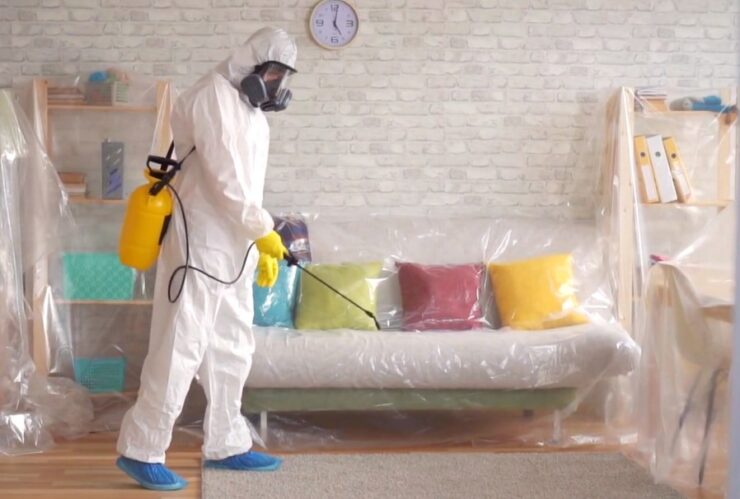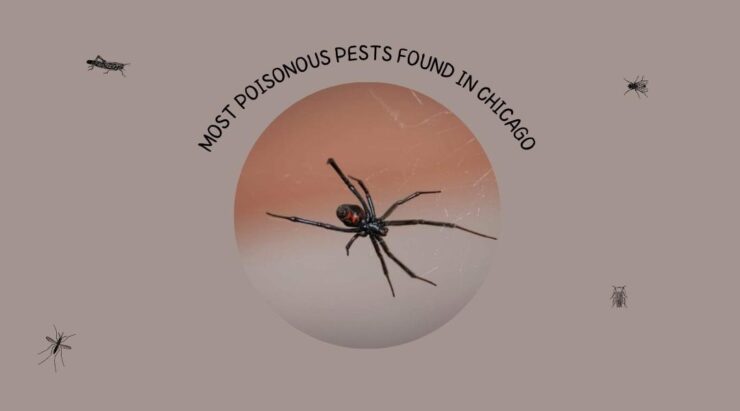Chicago, the Windy City, is renowned for its vibrant culture, iconic architecture, and bustling life. Yet, amid the hustle and bustle, there’s an unassuming, often unseen population that has been sharing this city space with us for centuries: pests. But not just any pests—these are some of the most poisonous ones you can encounter. Today, we delve into the world of these creatures, highlighting the threats they pose and what you can do to keep your household safe.
1. Brown Recluse Spider
The Brown Recluse Spider is undoubtedly one of the most dangerous pests found in Chicago. Despite its unassuming size—only about the size of a quarter—this creature is notorious for its venomous bite. If bitten, symptoms range from mild discomfort to severe skin necrosis in rare cases. Spotting them can be a challenge as they are, true to their name, reclusive in nature. They prefer undisturbed areas like attics, basements, and closets.
2. Black Widow Spider
The Black Widow Spider is another deadly arachnid found in the Chicago area. Identified by its shiny black body and the distinctive red hourglass marking on its abdomen, a bite from this spider can cause muscle pain, nausea, and in rare cases, more serious complications. While they are typically shy and prefer to avoid humans, they will bite if threatened or disturbed.
3. Yellow Sac Spider
Less known but equally dangerous, the Yellow Sac Spider is a common household pest in Chicago. These spiders are small and pale in color, which makes them difficult to spot. They build silken tubes or sacs in hidden places, hence their name. A bite from a Yellow Sac Spider can cause symptoms such as redness, swelling, and in some cases, necrotic skin lesions.
4. Eastern Yellow Jacket

Eastern Yellow Jackets are small wasps that can be identified by their distinctive yellow and black stripes. They are common in Chicago, especially during late summer and fall. Yellow Jackets are aggressive defenders of their nests, which are often located underground. Their stings can be incredibly painful and may trigger an allergic reaction in some individuals.
5. Bald-Faced Hornet
The Bald-Faced Hornet, while not a true hornet, is a species of wasp native to North America and a common sight in Chicago during summer. They are known for their large size, black and white coloration, and large, paper-like nests. While not naturally aggressive, they will defend their nests vigorously if disturbed, stinging repeatedly. Their venom can cause painful swelling and, in rare cases, severe allergic reactions.
6. American Cockroach

Though not venomous like the spiders and wasps we’ve discussed, the American Cockroach poses a different type of threat. As one of the most common pests in Chicago, they are potential carriers of various diseases, including Salmonella and E. coli, which can cause serious illness if they contaminate food or food surfaces.
Now that we’ve identified these pests, let’s discuss strategies to keep them at bay.
How to Keep Your Home Safe
- Regular Inspections: Regularly inspect your home for signs of infestation—webs, nests, droppings, or the pests themselves. Remember, the earlier you detect an infestation, the easier it will be to control.
- Seal Entry Points: Pests often enter homes through cracks and crevices. Seal these entry points to keep them out.
- Keep Your Home Clean: Many pests are attracted to food. Keeping your home clean, storing food properly, and promptly cleaning up spills will make your home less attractive to them.
- Regular Pest Control: Regular control treatments can help prevent infestations or catch them early before they become a major problem. Consider hiring a professional pest control service, especially if you’ve noticed signs of infestation.
- Safe Landscaping: Be mindful of your outdoor environment. Trim overgrown vegetation, clear away dead wood, and keep your yard clean to reduce potential nesting sites.
What to Do If You’ve Been Bitten or Stung
If you’ve been bitten or stung by a poisonous pest, it’s essential to act quickly.
- Stay Calm: Panicking increases your heart rate, which can cause the venom to spread faster. Stay calm and try to slowly move away from the pest to prevent further stings or bites.
- Clean the Area: Wash the wound with soap and water as soon as possible to help prevent infection.
- Seek Medical Attention: If you experience severe symptoms such as difficulty breathing, swelling of the face or mouth, or rapid heart rate, seek medical attention immediately. Even if your symptoms are mild, consider contacting a healthcare provider to discuss your situation.
- Observe the Pest: If it’s safe to do so, try to observe or capture the pest that bit or stung you. This can help medical professionals identify the species and provide appropriate treatment.
Additional Pests of Concern
1. European Paper Wasp
The European Paper Wasp is a recent arrival in Chicago, first spotted in the late 20th century. Although they aren’t as aggressive as yellow jackets, they can deliver a painful sting if threatened. Their nests, which resemble an upside-down umbrella, can often be found under eaves, railings, or other sheltered areas.
2. Northern Black Widow
The Northern Black Widow, a close relative of the Black Widow Spider, has been increasingly spotted in the Chicago area. Although they are shy creatures, their venom can cause significant discomfort and medical complications, making them a pest to be aware of.
3. Asian Tiger Mosquito
The Asian Tiger Mosquito is not native to Chicago but has found its way here, likely through international trade. They are aggressive biters and potential carriers of various diseases, including West Nile virus and Dengue fever.
Advanced Pest Control Methods

While regular inspections, sealing entry points, maintaining cleanliness, and safe landscaping are all critical steps in pest control, more advanced methods are available that can further safeguard your home:
1. Electronic Pest Control Devices
These devices repel pests by emitting ultrasonic or electromagnetic waves that pests find uncomfortable. Although the effectiveness of these devices varies depending on the pest and the specific device, they can be a valuable part of a comprehensive pest control strategy.
2. Biological Control
Biological control involves using the natural enemies of pests to control their populations. This could include releasing predatory insects that feed on the pests or using bacteria and viruses that are harmful to the pests but safe for humans and pets.
3. Heat Treatments
Heat treatments can be highly effective for certain types of pests, especially bed bugs. By raising the temperature in your home to levels that pests can’t survive, these treatments can eradicate pests without the use of chemicals.
4. Integrated Pest Management (IPM)
IPM is a comprehensive approach to pest control that combines various methods, including regular inspections, physical control methods (like sealing entry points and removing nests), chemical control when necessary, and ongoing monitoring to ensure the methods are working.
Final Words
While the idea of sharing your home with poisonous pests can be unnerving, it’s important to remember that most of these creatures prefer to avoid human interaction. They bite or sting primarily in self-defense. By being aware of the potential threats, keeping your home clean and well-maintained, and seeking professional help when needed, you can effectively reduce the risk posed by these pests and keep your household safe.
So, as you enjoy the beauty and vibrancy of Chicago, remember that even the tiniest creatures have their place in our city’s vast ecosystem. With a little knowledge and precaution, we can coexist safely with these pests, appreciating the intricate balance of nature that persists even in the heart of our urban jungle.
